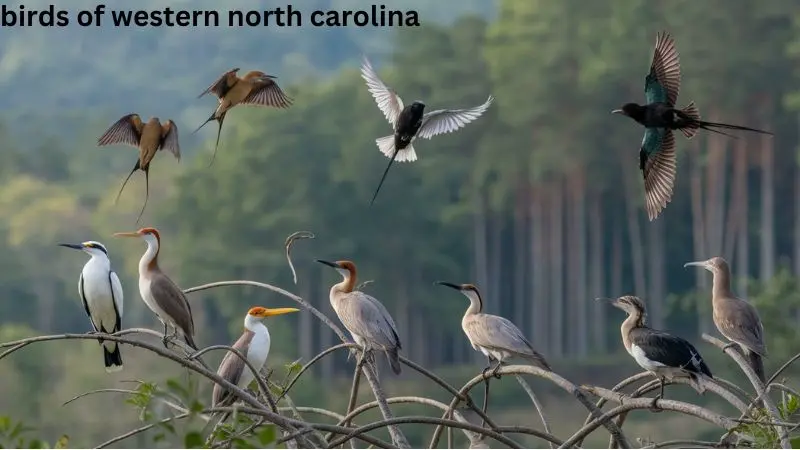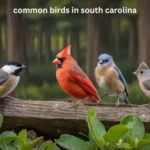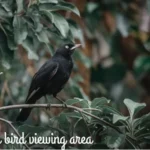Bird Identification
Discovering the Diverse Birds Of Western North Carolina
Western North Carolina, with its varied landscapes and rich natural habitats, is a paradise for bird enthusiasts. From the lush valleys and rolling hills to the majestic peaks of the Blue Ridge Mountains, this region is home to an incredible diversity of avian species. In this article from Bird01.com, we will explore the fascinating world of birds in Western North Carolina, providing insights into some of the most notable species, their habitats, and tips for birdwatching in this beautiful part of the state.
The Rich Avian Diversity of Western North Carolina
Western North Carolina is known for its diverse ecosystems, including hardwood forests, mountain streams, and open fields. This range of habitats supports a wide variety of bird species, making it a prime location for birdwatchers and nature enthusiasts.
The Blue Ridge Parkway: A Birdwatcher’s Haven
The Blue Ridge Parkway, often referred to as “America’s Favorite Drive,” stretches over 400 miles through the Appalachian Mountains and is one of the best places for birdwatching in Western North Carolina. The Parkway offers numerous overlooks and trails where birdwatchers can spot species such as the Scarlet Tanager, Eastern Towhee, and American Redstart. During the spring and fall migrations, this area becomes a hotspot for observing a variety of warblers, vireos, and thrushes.
High-Elevation Birds of the Great Smoky Mountains
The Great Smoky Mountains, which straddle the border of North Carolina and Tennessee, are known for their unique high-elevation bird species. At altitudes above 5,000 feet, you can find birds that are not commonly seen elsewhere in the region. The Black-capped Chickadee, a species typically associated with the northern United States, is one of the highlights of birdwatching at these elevations. Other notable species include the Winter Wren, Northern Saw-whet Owl, and the colorful Blackburnian Warbler.
The Catawba River Valley: A Sanctuary for Waterfowl
The Catawba River Valley, with its network of rivers, lakes, and wetlands, provides crucial habitat for waterfowl and wading birds. Species such as the Great Blue Heron, Green Heron, and Wood Duck can be seen year-round. During the winter months, the area attracts migratory ducks, geese, and other waterfowl, making it an excellent spot for birdwatchers looking to add some variety to their bird lists.
Notable Birds Of Western North Carolina
The Red-cockaded Woodpecker
One of the most significant bird species found in Western North Carolina is the Red-cockaded Woodpecker. This bird is classified as an endangered species and is dependent on mature pine forests with an open understory. The Sandhills region, located just to the east of the mountains, is a stronghold for this species. Conservation efforts are ongoing to protect and expand suitable habitats for these woodpeckers.
The Peregrine Falcon
The Peregrine Falcon, once nearly extinct in the eastern United States due to pesticide use, has made a remarkable comeback in the Appalachian region. These birds are often seen nesting on cliffs and ledges in Western North Carolina. The dramatic sight of a Peregrine Falcon in a high-speed dive, or “stoop,” is a thrilling experience for any birdwatcher.
The Cerulean Warbler
The Cerulean Warbler, a small, sky-blue songbird, is a species of concern due to habitat loss and fragmentation. This bird breeds in the mature deciduous forests of the Appalachian Mountains. Birdwatchers can spot Cerulean Warblers in areas like the Nantahala National Forest during the spring and summer months, where they sing from the canopy of tall trees.

The Eastern Bluebird
The Eastern Bluebird is a favorite among birdwatchers and is known for its bright blue plumage and cheerful song. This species is often seen in open fields and meadows with scattered trees. Thanks to the efforts of bird enthusiasts who provide nest boxes, the Eastern Bluebird population has been steadily increasing in recent years.
The American Goldfinch
Known for its vibrant yellow feathers, the American Goldfinch is a common sight in the open fields and gardens of Western North Carolina. These small, lively birds are a delight to observe, especially during the summer breeding season when their plumage is at its brightest. They are often attracted to feeders filled with thistle seed.
Tips for Birdwatching in Western North Carolina
For those looking to explore the avian diversity of Western North Carolina, here are some tips to make the most of your birdwatching experience:
Best Times for Birdwatching
The early morning hours are generally the best time for birdwatching, as this is when birds are most active. Spring and fall migrations are also excellent times to observe a wide variety of species, as many birds pass through the region on their way to and from their breeding grounds.
Recommended Birdwatching Locations
- Chimney Rock State Park: Known for its Peregrine Falcons and a variety of songbirds.
- Max Patch: A bald mountain with panoramic views and opportunities to spot high-elevation birds.
- Lake Junaluska: A great spot for observing waterfowl, especially during the winter months.
Essential Birdwatching Gear
A good pair of binoculars is essential for any birdwatcher. A field guide specific to the region, such as “The Birds of North Carolina,” can help with identification. A notebook or birdwatching app is also useful for keeping track of your sightings.
Join a Birdwatching Group
Joining a local birdwatching group or participating in bird counts can enhance your experience and provide opportunities to learn from more experienced birders. Organizations such as the Carolina Bird Club and the National Audubon Society offer resources and organize events throughout the year.
Conservation Efforts and Challenges
While Western North Carolina is a haven for birds, there are significant conservation challenges. Habitat loss due to development, climate change, and invasive species all pose threats to local bird populations. Organizations like the Audubon North Carolina and the Blue Ridge Conservancy are actively working to protect vital habitats and support conservation initiatives.
Habitat Protection
Preserving and restoring habitats is crucial for the survival of many bird species. Efforts are underway to protect key areas such as the Southern Appalachian Highlands Conservancy, which safeguards large tracts of forest and meadowland that are essential for breeding and migratory birds.
Climate Change Impact
Climate change poses a significant threat to bird species, particularly those adapted to specific altitudes and temperatures. As temperatures rise, some species may be forced to move to higher elevations, which could lead to a reduction in suitable habitat. Monitoring and research are needed to understand the full impact of climate change on Western North Carolina’s bird populations.
Public Education and Engagement
Raising awareness about the importance of bird conservation is key to protecting these species for future generations. Bird festivals, educational programs, and citizen science projects, such as the annual Christmas Bird Count, engage the public in conservation efforts and foster a greater appreciation for the region’s avian diversity.
Conclusion
Western North Carolina is a treasure trove for birdwatchers, offering a rich variety of species and habitats to explore. From the high peaks of the Smoky Mountains to the peaceful valleys of the Blue Ridge, there is no shortage of opportunities to enjoy the region’s birdlife. By supporting conservation efforts and staying engaged with the birdwatching community, we can help ensure that these beautiful and diverse bird species continue to thrive in this magnificent part of the world.
Whether you are a seasoned birder or a curious beginner, Western North Carolina has something to offer everyone. Grab your binoculars, head out to one of the region’s many birdwatching hotspots, and experience the joy of discovering the feathered wonders of this unique and vibrant ecosystem.






